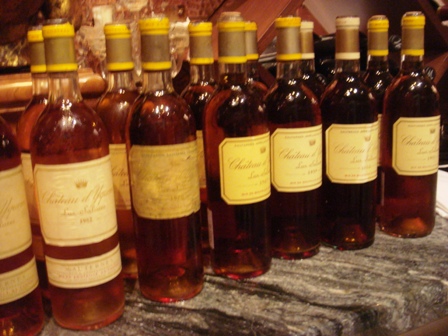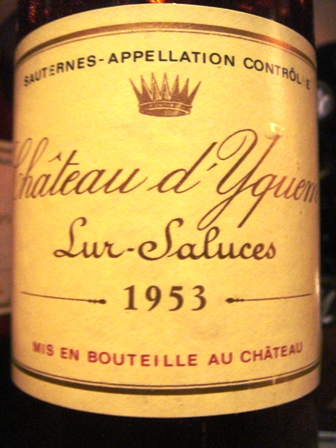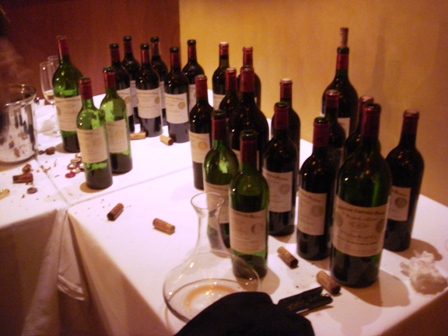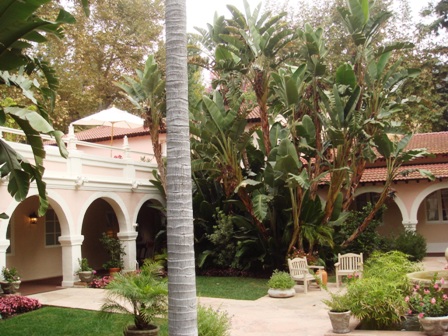After a small break following the great lunch of the greatest Cheval Blanc, we met again for the first meal devoted to Yquem, a dinner by Chinois on Main, with the cook of Luis Diaz and Rene Mata, and with the supervision of wines by Christian Navarro. The tasting is conducted by Bipin Desai and the guest of Honour is Pierre Lurton, who will give very precise data on every year with dates of crop, yield, proportions per variety of vine, alcohol, acidity and sugar levels. As I arrived early from my hotel, I could see all the golden bottles standing under the benevolent protection of a Buddha, whose face seemed to indicate that such devotion was accepted by Him.
The menu consists in : passed hors d’oeuvre / Pithivier of stir-fried squab with roasted sweet potato puree / Santa Barbara prawns on sweet and sour beets with sesame seed and plum wine emulsion / roasted Kurobota pork loin with slow braised shoulder, dry apricots and toasted almond / upside down passion fruit cheesecake with pineapple sabayon.
Except the pork loin, I have not been impressed by the attempt of matching with Yquem, which can be achieved better. But the place is so charming and the staff is so active that we spent a very nice time.
I just give an anecdote which made me smile. When I make dinners with great chefs devoted to old wines, I ask them to simplify their cook, telling them that a simplified cook can be delicate and can show the talent of the chef. When the pork loin arrived on the table, there were just slices of meat, with no sauce, no extra accompaniments. And I thought : “wow, they understood what will fit to Yquem”. And then, a waiter comes with a huge pot and fills the plates with another meat (the shoulder), with vegetables and sauce. I had rapidly eaten the simple meat with an Yquem, just to check that it worked well. The more complex dish was heavier to be a real friend to Yquem.
The first flight : Yquem 2003, 2000, 1998, 1995, 1982, 1970
The examination of the smells is not of a great help for such young wines. I just noticed that the greatest nose was the one of the 1970, which is normal as it is the oldest. The 2003 has taken body since the last time I tasted it. I see fig, fat fruit, oriental pastry, as the wine is opulent, fat. A really great wine.
The 2000 is more elegant, more discrete, but the sugar appears more. It is a less interesting Yquem. The 1998 is neatly lighter. A more limited Yquem which never convinced me. It has not the personality that the others have. The 1995 that Alexandre de Lur Saluces complimented a lot at its first appearance is elegant, but I find it too monolithic, too simple. The 1970 is now on my lips : this is a wine ! The sugar is very scarce, the elegance, sweetness and charm are there. It is probably not the most imaginative, but I like its airiness on mouth and its apricot taste. The 1982 has a very nice attack with citrus fruit. It has balance, structure, serenity. It is typically a wine for gastronomy.
My ranking : 1982 – 2003 – 1970 – 2000 – 1995 – 1998.
The ranking considering the potential would put the 2003 above the 1982.
Second flight : Yquem 1986, 1961, 1953
The colours of the two older are fantastic. It is what Yquem should look like. The 1986 is slightly bitter, but with time, it has gained in elegance. This wine has been a sleeping beauty for a long time. It is very probable that it will have a positive development. With the 1961 we enter in a new generation of Yquem. This wine has balance, but more than that, an easiness à la George Clooney. It is in a mango phase. The 1953 is completely feminine. Contrarily to wines which require a dish, this 1953 has such a lovely sweetness that it should be drunk alone, to enjoy the subtlety.
Pierre Lurton finds that the 1961 has a rather bitter final, but in fact this wine abandons progressively its sugar and becomes dryer, as it happens more frequently for the decade 30ies.
Tasting again the wines I find that the 1986 would go very well with a lobster, and even if the final is not the most spectacular, I find it pleasant. The 1961 gets notes of tea, dries a little but is a nice wine. The 1953 is excellent.
My ranking : 1953 – 1961 – 1986.
Third flight : Yquem 1983, 1967, 1959, 1955
In the 1983, the sugar is very noticeable, but compensated by a nice acidity of citrus fruit. It is a classically good Yquem.
The 1967 has an attack of tea, of bitter wood. But the volume of this wine is enormous. It is very interesting as it is absolutely not conventional. I love the unconventional aspect of this wine. The 1959 is very light, airy and subtle. What a contrast with the 1967 ! It is extremely elegant. The 1955 is the synthesis of the two previous wines. It has everything. There are candied fruits. The final is imposing.
I make a second and a third round to try to decide which the first is as it is complicated. The 1967 is very big, but has aspects of tea. So, I prefer the 1955. The 1959 is greater and greater. It is extremely difficult to choose. I begin to write 1955 – 1967 – 1959 – 1983.
But in fact my ranking is : 1955 – 1959 – 1967 – 1983. The fact to put the 1967 only in third place shows how good the two others are. Bipin says that the 1967 is the most “exotic” of all the Yquem and says : “it is the more Pomerol of Sauternes”.
The 1955 has elegance, the 1959 has a peppery final, the 1967 has an incredible power, and it’s a bomb. The 1955 is the lighter one, but for me it is exactly in the historical line of Yquem. I come back to the previous flights with the 1982 which is very good and the 1970 which does not keep the distance.
All of us we talk of our choices, which are very different, and the question which arises to me is “what do you expect from an Yquem?”. It is clear that some people want power, which is not my search. It explains why the preferences were very different. It is a good thing, as every Yquem will have its fan club.
It was a wonderful evening, with nice wines and a rather disappointing food, as the chefs did not enter in the world of Yquem.
Our group meets again the next day for lunch. The fourth event of this incredible serie of tastings is a lunch by Spago Berverly Hills, with a menu composed by Wolfgang Puck, a talented chef whose origin is in Austria, and with the efficient management of the wines and the glasses by Christian Navarro. Pierre Lurton is once again the guest of honour of the lunch organised by Bipin Desai.
The menu consists in : hors d’oeuvres / wood oven-roasted, prosciutto-wrapped Maine monkfish with onion-date puree and Thai spices / roasted breast of Scottish pheasant with shepherd’s pie of braised leg and butternut squash / grilled Snake River Ranch Kobe New York steak with Matsutake mushrooms / Stilton and Roquefort / apple and fennel sorbet with pixie tangerines, lime marinated persimmon with anise wafers.
This has been the most elegant cook, perfectly adapted to old Yquem, and I am so happy that the chef had the courage to propose a Kobe beef on old Yquem. It worked wonderfully. I am in favour of such risks, and it pays.
The first flight : Yquem 1976, 1975, 1948, 1947, 1934
The deepest colours are the ones of the 1947 and the 1948. The 1934 is lighter, and in my glass a little troubled, which does not appear for my neighbours. The nose of the 1975 is corked, and I learn that for the other group, it is the 1976 which is corked. We exchanged a part of the good pours for the ones having the corked pours.
The nose of the 1948 is marvellous. It has an incredible strength and could be smelled as an alcohol. The nose of the 1947 has an infinite subtlety. It is as sexy as a perfume. The nose of the 1934 is balanced and sweet. The nose of the 1976 is very strong in alcohol.
The 1976 in mouth is very fat, suggesting candied fruits. A very excellent Yquem. The 1975 does not suffer too much from being corked. But it is not what it should be. I can imagine that it could be great. I received parts of two glasses of the good 1975. I was not convinced at all, as I do not like so much such manipulations.
The 1948 is an angel who comes smoothly from the sky. For me, it is the expression of happiness. Nothing is exaggerated, all is delicious. There is even a little of butter in the taste. This Yquem is “the” Yquem that I would wish to drink for ever. A pure dream. We will drink later some Yquem that I will rank above, due to their outstanding performance. But this one is for me a pure joy, as the old jacket that you cherish. You have clothes with very expensive cut or material. But there is one jacket- generally rather old – that you wear with a total pleasure. This is what I find in the 1948.
The 1947 has an enormous power. It is a Sumo. It is perfect, but for my taste, I prefer the more subtle 1948. The 1947 coming from a magnum is glorious. The 1934 is very surprising. For my opinion it has changed its original taste, evolving towards a combination of alcohol and matured oranges. If this wine were drunk alone, we would find it absolutely superb. But put together with the 1947 and the 1948 it is a too heavy challenge. I try again and I find in the 1947 a total perfection. The 1948 is of a total charm, but I must say that the 1947 is greater. The sauce is fantastic with the wines, Wolfgang Puck, who has tasted all the wines (not bad !), has adapted the sauces to the wines. The 1947 and the 1948 are equal in my ranking, and the 1934 is the best 1934 that I have ever tasted, as all the elements are now integrated. The 1976 is great, the 1975 lacks of charm. Finally, the 1948 is what I look for in Yquem, so I will put him as first.
My ranking : 1948 – 1947 – 1976 – 1934 – 1975.
Bipin asks me to make comments on the wines, and I say that when I have in front of me the total perfection of Yquem, I am like a kid in a candy store, I enjoy !
Second flight : Yquem 2001, 1997, 1990, 1989, 1988
The 2001 appears to be much sugared, it evokes candied fruits. I feel the enormous potential of this perfect wine, but it is very difficult for it to be served after the 47 and the 48. The 1997 is very elegant, easy going, peppery. It is the type of Yquem that I like. I find similarities with the 1948.
The 1990 offers coffee, blond fruits. It is nice, but it lacks length. Very fruity Yquem. The 1989 is very citrus fruits. Lighter than the 1990 it is very elegant. Citrus fruits, with a very nice and elegant finish. The 1988 is the more balanced. It has not many singularities. It looks as if it would be “established”. The 2001 is in a phase when the sugar dominates. It is not at its advantage and we should wait before drinking it again. The 1997 is the recent example which is the most in the historical line of Yquem. The 1988 is too politically correct. It plays a little under its talent. I was in the camp of those who prefer the 1988 in the trilogy, but here, it is the 1989 which is the nicest. The 1989 is the most elegant, and the 1990 shows too much its sugar.
For an immediate pleasure and not on the potential, my ranking is : 1989 – 1997 – 1988 – 1990 – 2001. The greatest potential is for 2001 and 1988. But now, the freshness of the 1997 and the balance of the 1989 put them at the top.
After several new tries, the 1988 becomes greater than the 1997, so my final ranking is 1989 – 1988 – 1997 – 1990 – 2001.
Bipin says that the 2001 is “larger than life”. Every aspect of this wine is above any norm.
Third flight : Yquem 1949, 1945, 1937, 1921, 1899.
It is hard to imagine having these five glasses in front of me. I see around me that it seems natural. But it is not!
Ranking the colours from the more deep to the lighter, it gives : 1921 / 1899 / 1937 / 1945 / 1949. The nose of the 1945 is very elegant. The nose of the 1937 has an infinitesimal problem. The 1949 evokes brown fruits. The 1921 has the absolute purity of a perfect smell. The 1899 has an elegant racy nose. The total nobleness.
I begin to drink. The 1949 is totally elegant, with a rather short finish. It must be said that all these wines are above 100 points. So to criticise is like to say : “ I do not like so much the curve of the nose of Mona Lisa”. All what I have to say about the 1945 is that it is totally perfect. It is elegant and has a fabulous balance. It is exceptional with an enormous finish.
The 1937 is more fluid, acidic, very much in the style of the decade 30ies. It is very different from the style of the 40ies. There is grapefruit, green citrus. It is a wine for gastronomy, a great Yquem. The 1921 is completely atypical. There is tea and coffee, but also lemon. The length is unique. It is great, opulent, and comfortable. If I had to make a critic, I would say that it lacks a little of eccentricity.
The 1899 is a truly great Yquem. Tea, candied fruit, combined with green lemon, and the sensation is above the one of the 1921. In the 1899 there is alcohol, in the 1921 there is caramel, and my taste is not so much in favour of Sauternes which have developed their caramel side.
My ranking : 1899 – 1921 – 1945 – 1937 – 1949. But, how many wines in the world could be ranked above the fifth of this flight?
I had changed my vote several times as it was difficult to say between the 1945 and the 1937. The 1945 is a little more singing and sunny.
I come back to the 1947 of a previous flight which has developed a taste of dry grape. And it is very rare.
My final ranking for this evening is : 1899 – 1921 – 1945 – 1948 – 1947 – 1937 – 1989 – 1988 – 1976.
If I say now that the 1899 that I shared in Yquem with Pierre Lurton was above this 1899, one can imagine what I had lived at that moment.
This tasting shows that the older Yquem is, the best it becomes (if one chooses the great years), and it shows that the decade of the 40ies is super performing. I said that what is unique in Yquem is that for almost every wine, we could say that we had the best possible bottle.
To open an Yquem is certainly what gives the greatest chance to have an immense wine. We were lucky enough to have Pierre Lurton bringing so many fabulous wines. Bipin Desai organised the flights with a rare intelligence. Christian Navarro made a fantastic job to give us wines in a good shape and a good condition of tasting. Wolfgang Puck made a magical cook which gave ideas to Pierre Lurton to dare more with the food.
Everything was perfect. The four meals that we had will belong to the group of the best events that I have lived.












































